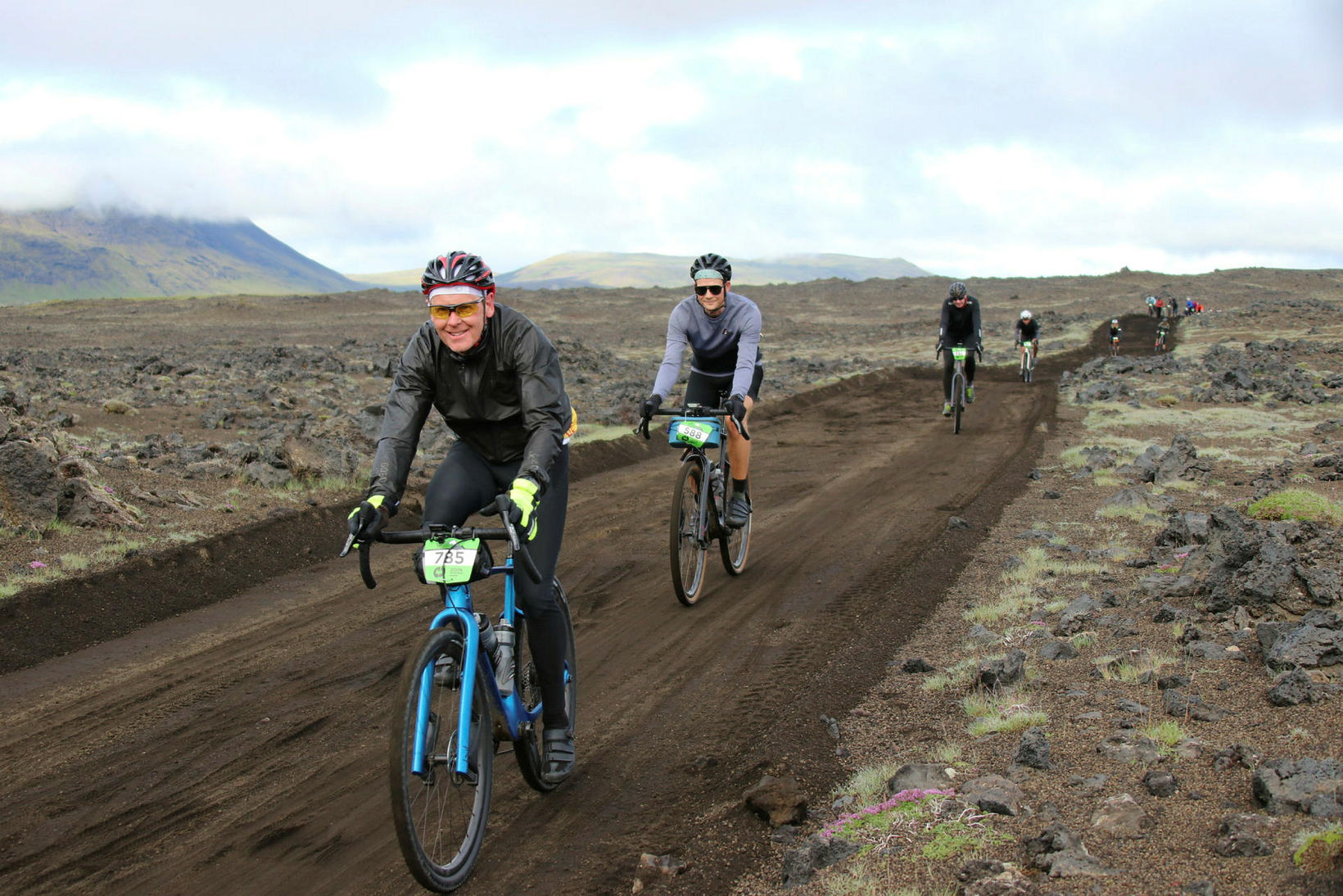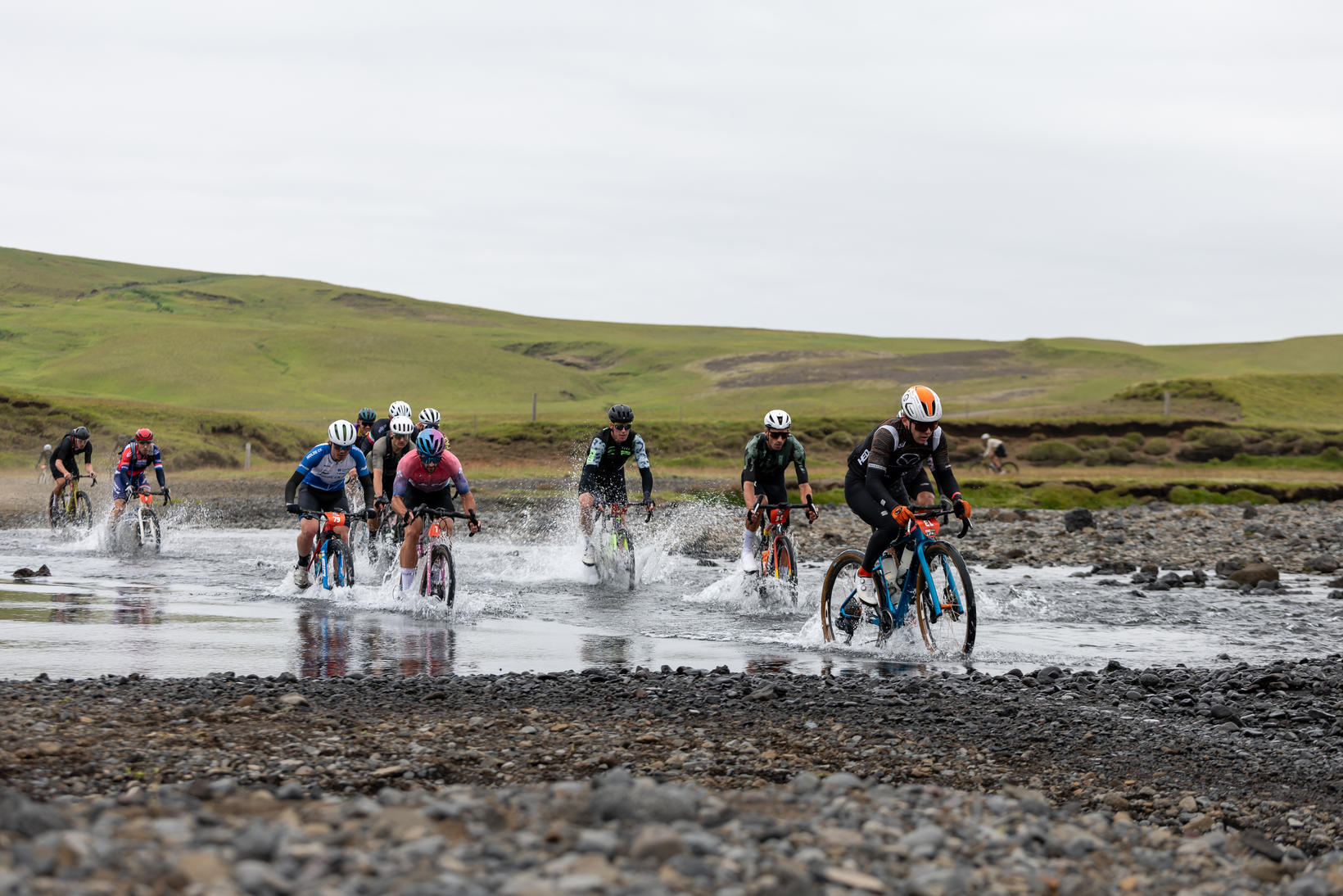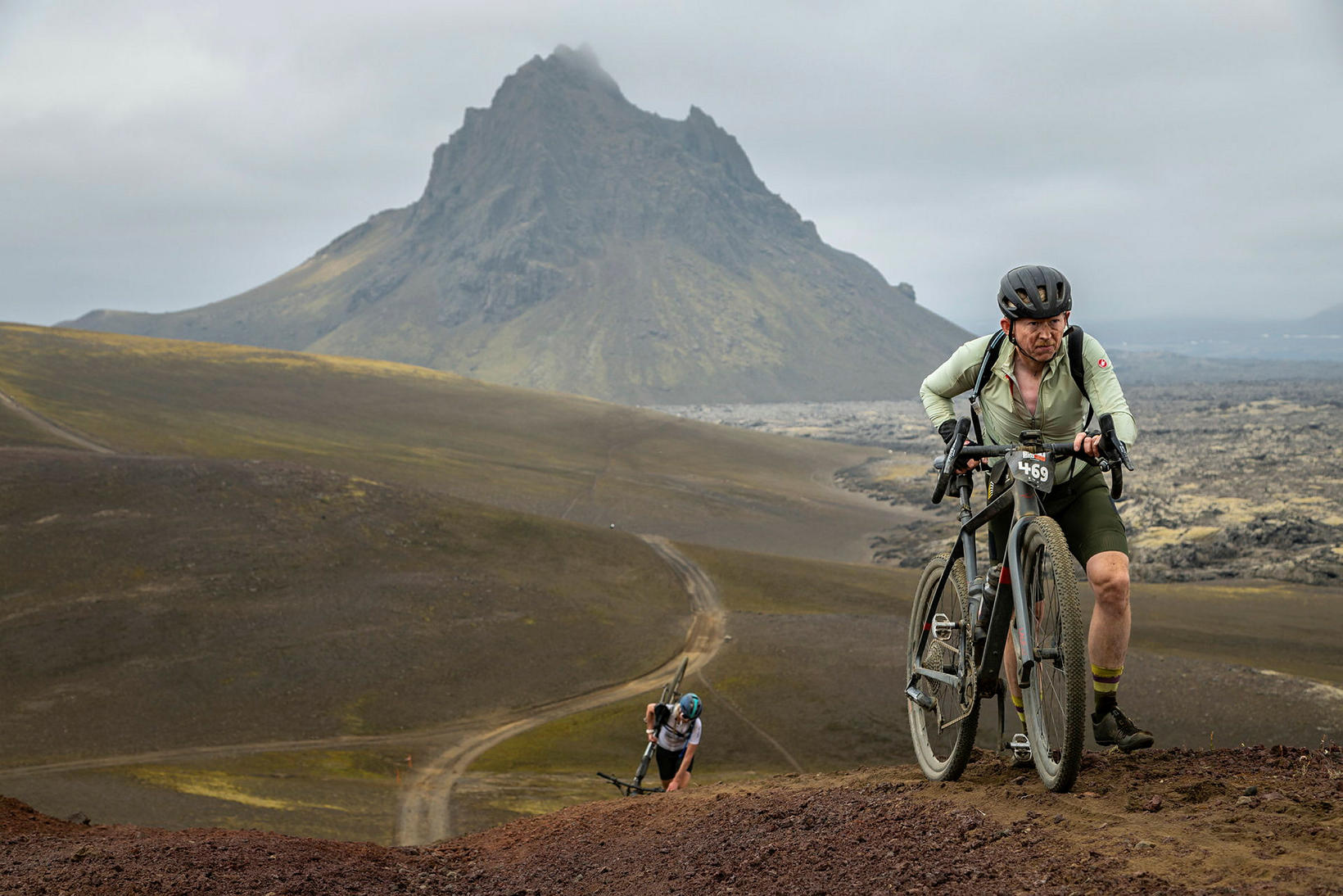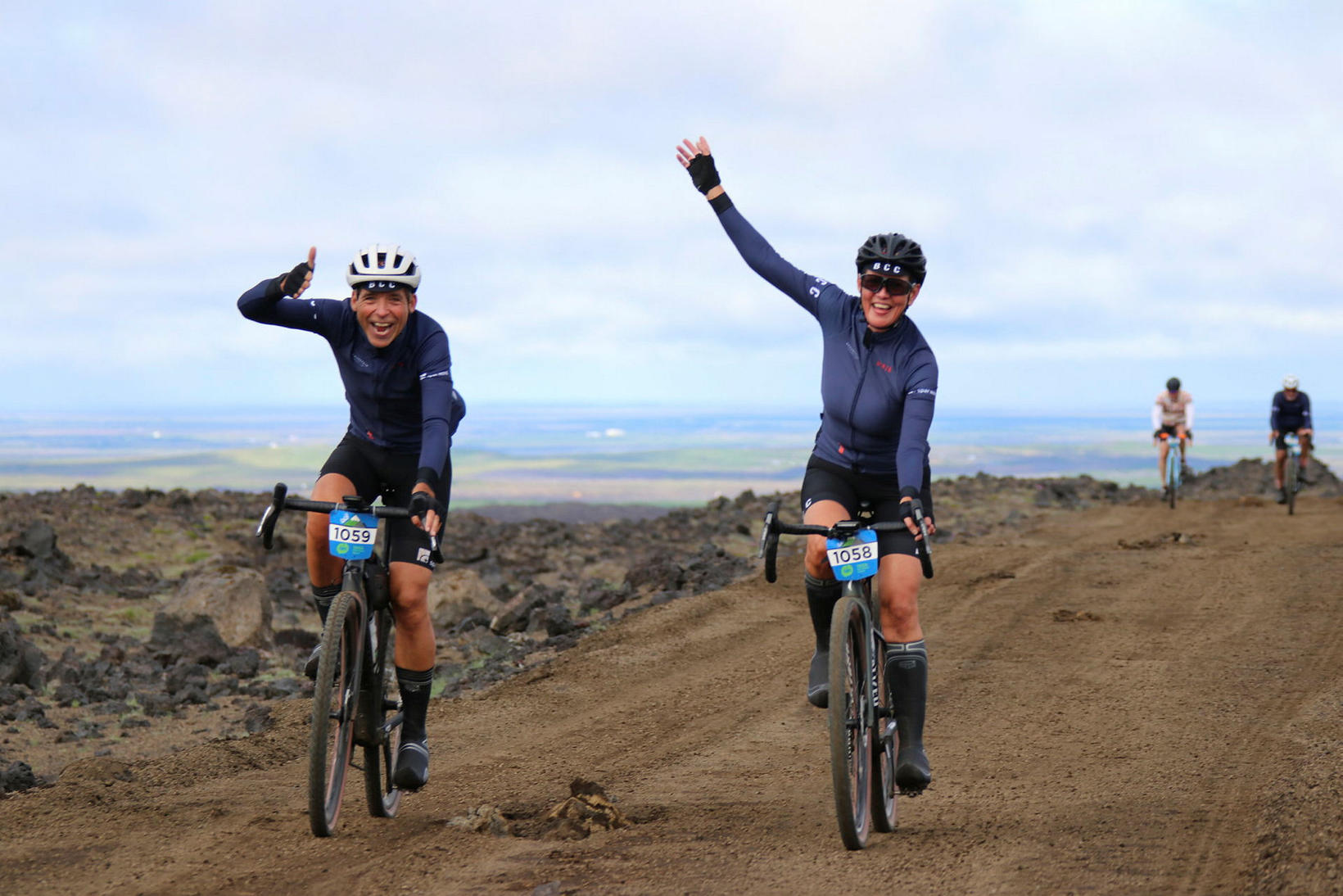Cyclists will take over Hvolsvöllur this weekend
The race starts at Hvolsvöllur and from there the cyclists ride up Syðri-Fjallbakur and to Landmannahellir, around Mt Hekla, and back, all in all, it's 200 km. Photo/The Rift
Almost 1,200 competitors are enrolled in the International Bike Race The Rift, which begins at Hvolsvöllur tomorrow, Saturday. The race will take place on the 200-kilometre route the competitors will cover. The vast majority of the competitors are from abroad, and about half of them have participated before. According to the weather forecast, weather gods will be on the team with the cyclists.
The organisers of the competition, Lauf Cycles, say that this year they have focused on making the area around the end zone of the race as much fun as possible, for the competitors, their families, and other viewers. They encourage cyclists to gather after the festival at Hvolsvöllur on Saturday to participate in the cycling party and create a fun atmosphere.
A pilgrimage to Iceland
This is the fifth time the competition has taken place, but it attracts around 3,000 foreign visitors every year, as it is very common for the competitors to come with families and stay in Iceland for some time before and after the competition.
The competition was first held in 2019 after the company launched its first gravel bike. The competition became a one-off pilgrimage for cyclists who wanted to ride around the landscape where the idea for the Lauf bikes was born. The bikes have finally attracted attention in recent years due to their special flexible suspension fork, which is somewhat different from the traditional demurs on bikes.
Many people come year after year
Ólafur Thorarensen, sales and marketing manager at Lauf, says that of the nearly 1,200 registered, 90% are from abroad and the vast majority are from the United States, where gravel cycling has been very popular. Thorarensen says that the rest of the foreign competitors come from around the world, but most of them are from Europe. The longest-distance competitors come from Australia to take part in the competition. Up to half of them have also come before and many more than once. It is therefore clear that the competition has a strong place for many gravel cyclists who have marked the competition as an annual event on their calendar.
Ever since The Rift race has been on, it has been sold out, but the second year the competition had to be cancelled due to the pandemic. Since then, it has grown and demand has always been greater than the supply of tickets. In the first three years, the number of tickets to the competition increased somewhat and reached its current number. That number has been holding up since then, but Thorarensen says that it’s actually a lack of accommodation in the vicinity of Hvolsvöllur that prevents the competition from getting even bigger. Starts are early in the morning, so the competitors are not excited to stay in the capital area, having to drive more than 100 km in the middle of the night.
“We don’t want to increase the number of competitors much, but 1,500 competitors would be awesome,” he says, pointing out that a new hotel is being built on Hvolsvöllur, which will probably help in coming years.
A few rivers are on the route, like this one in Fiská River. Some people just power through, while others choose the safer bet and jump off the bikes. Photo/The Rift
Staying more nights at Hvolsvöllur
Thorarensen also mentions that the average stay of competitors at Hvolsvöllur and the surrounding area during their visit to Iceland is 3-4 nights. During the high summer season it is not uncommon for tourists to drive around the country and the average time in each location is fewer nights, and he says that this is especially good for the tourism industry. In addition, he says that a large part of those who participate take advantage of the opportunity and travel around the country for a week before or after the competition.
The Rift is both a competition for professional players who see success as a big boost to their careers and for amateurs who are competing with themselves and others in similar abilities. It is not uncommon for people who are approaching middle age to find themselves in outdoor activities, whether it is an outdoor-run or cycling, and Thorarensen says it is no secret that the majority of The Rift participants are between the ages of 40 and 60.
“These are people in all kinds of shapes,” he says, pointing out that some are like professional-looking people while others are more thoroughly grown-up and enjoy living and enjoying than making the best time. Mostly, it’s about competing with yourself. With this age group, he says, there are also generally fairly wealthy tourists who are on more expensive types of bikes and who, despite high prices, come to Iceland and travel with their families.
Organizing a big competition like this, where you cycle 200 km, most of it in the highlands isn’t a simple operation. Thorarensen says that Lauf hired a special organizer, Hrannar Hafsteinsson at Live Production, to take care of installation, labeling, and other issues related to the competition. In all, that work probably amounts to 25-30% of the work over the year. By the same token, he spends about 15% of the year just having to do with outside management, communication, and other matters related to the competition.
As the race approaches, this percentage increases somewhat, and he jokes that last night was probably the last one of three or four days, where he gets a proper sleep. He says, all the attention of Lauf’s other employees goes to the race in the last days before the start.
The cyclist legend Guðlaugur Stefán Egilsson with Mt Krakatind in the background on one the steepest part of the route. Very few, if any, manage to ride up this hill, but the ride downhill is all the more exciting. Photo/The Rift
70 employees around the competition
Thorarensen says that Lauf Cycles has been extremely lucky with the team around the competition and it has been largely unchanged for the last three years. Apart from starting the race and the enclosure at the finish, the track needs security, employees need to be at drinking and dining stations, assistance with getting over rivers and general management. He says that the group always grows when the competition draws closer, but on the day of the competition, there are nearly 70 employees.
Not only is there a 200 km distance, but 100 km is also offered, and Thorarensen says that 25% of the participants will take that distance. A comfortable 45 km bicycle is also available on race day, which is popular with the competitors’ spouses and others who show up to watch. You don’t need to sign up for that route, and it starts at about 10 am on Saturday.
Changes in the women's category
This year, it was decided to change the women’s category so that the women’s team will start half an hour before the men’s, or at 7:00 AM while the men’s team starts at 7:30 PM. Thorarensen says this is done to make it easier for women’s competitors to have their competition and be more competitive with other women than men’s. The proportion of women among participants is about 20%, but this is more than 200 women, so it’s a fairly large group.
Among the foreign competitors who will probably be in the lead of this year’s competition are Simen Nordahl Svendsen, who was a surprise winner last year and will probably do everything he can to defend the title. In the women’s category, there will be Morgan Aguirre, who rides with Enough Cycling, and Leah Van der Linden. It’s also worth mentioning that three of the biggest Icelandic hopefuls are up for the competition, namely the trio of Kristinn and Davíð Jónsson, and Breki Gunnarsson. Also, the old-timer Hafsteinn Geir Ægisson is up for the competition, and it’s never possible to rule him out. Thus, when Kristinn Jónsson became the Icelandic champion in street bike riding, Ægisson was second.
The competitors in The Rift have different goals. While some are competing on the clock, others are striving to get their personal best and conquer Icelandic nature and manage to cover the 200 km. Photo/The Rift
“Come and enjoy with us”
Thorarensen says that this year, more emphasis will be placed on the goal and the surrounding area. “We’re going to make it a much more fun experience when people come to the goal.” He says that there will be much more to offer than just coming to the goal and then going straight to a hotel shower. Last year, there was a pretty good ambiance when people had a hot dog and something to drink after the race and relaxed to to chat with other riders. He says that more emphasis is placed on this area to create the best atmosphere. There will be lots of activities on offer, jumping castles for children, ice baths to lie down in right after the race, and much more. The main emphasis is to create good memories for everyone who comes.
“We encourage all those who are interested in cycling to come to Hvolsvöllur after noon and welcome the cyclists at the finishing line, have a hot dog and something to drink with it. You’re only an hour and a half east and we’ll have fun at the end,” he says, “Come and enjoy with us because it’s a real competition.”









/frimg/1/53/30/1533092.jpg)

